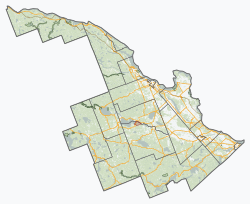Eganville | |
|---|---|
Unincorporated community | |
 | |
| Coordinates: 45°32′N 77°06′W / 45.533°N 77.100°W | |
| Country | Canada |
| Province | Ontario |
| County | Renfrew County |
| Township | Bonnechere Valley |
| Government | |
| • MPs | Cheryl Gallant (Renfrew—Nipissing—Pembroke) |
| • MPPs | John Yakabuski (Renfrew—Nipissing—Pembroke) |
| Area | |
| • Land | 2.26 km2 (0.87 sq mi) |
| Population | |
• Total | 1,149 |
| • Density | 508.2/km2 (1,316/sq mi) |
| Time zone | UTC-5 (Eastern (EST)) |
| • Summer (DST) | UTC-4 (Eastern (EDT)) |
| Postal code | K0J 1T0 |
| Area codes | 613 and 343 |
Eganville is a community occupying a deep limestone valley carved at the Fifth Chute of the Bonnechere River in Renfrew County, Ontario, Canada. Eganville lies within the township of Bonnechere Valley.
Eganville is also known as the Ordovician Fossil Capital of Canada. There are many fossils to be found in this area from approximately 500 million years ago (in a time before dinosaurs) including coral, crinoids, trilobites, cephalopods, gastropods, pelecypods, stromatolites, and brachiopods. The Bonnechere Valley is also a gateway to some of north-eastern Ontario's best-known tourist destinations, including the nearby Bonnechere Caves. The caves are located under a hill of limestone, said by geologists to have been the bottom of a tropical sea 500 million years ago.[2] The Bonnechere Museum, through a partnership with the Bonnechere Caves, offers fossil hunts four times in a summer season where people can practice finding fossils and even take one home if they find a good one.[3] Eganville is also home to a Geo-Heritage Walking Trail located along the Bonnechere River which features a fossil pit, a visit to an old quarry, a trench, wild plants, and scenic lookouts.
Eganville is a stop to destinations into central Ontario. Ontario Highway 41, which runs north–south from Pembroke to Napanee, intersects with Ontario Highway 60 in Eganville.
The town of Eganville is the fifth of five chutes along the Bonnechere River, the others being Castleford, Renfrew, Douglas and Fourth Chute. The chutes were used for moving timber past rapids and waterfalls.
- ^ a b "Eganville Ontario [Population centre] Census Profile, 2021 Census of Population". www12.statcan.gc.ca. Government of Canada - Statistics Canada. Retrieved 19 July 2024.
- ^ "Show Caves of Canada: Bonnechere Caves". Retrieved 23 September 2014.
- ^ "Bonnechere Museum Events". Archived from the original on 10 August 2015. Retrieved 6 August 2015.

